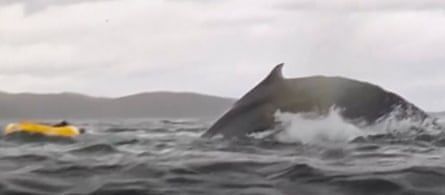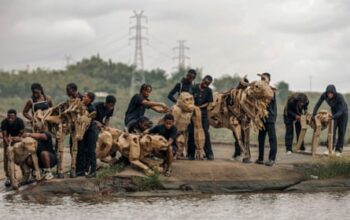Adrián Simancas had been paddling for two hours in the calm but icy seas of the Strait of Magellan, off the coast of Chilean Patagonia, when something massive emerged from the water and dragged him under.
“I saw dark blue and white colours before feeling a slimy texture brush against my face,” the 24-year-old told the Guardian. “I closed my eyes to brace for impact, but it was soft, like being hit by a wave.”
In an incredibly rare turn of events, Simancas had been sucked entirely into the mouth of a humpback whale. He closed his eyes and held his breath.
“When its mouth closed around me and pulled me down, I felt like I was in a whirlpool, lying down and spinning around,”he said. For a few fleeting moments, his fate was in the jaws of the 40-tonne cetacean. “If it had eaten me, I would’ve died. There was nothing I could do about it.”

The terrifying ordeal lasted only a few seconds. Before he knew it, Simancas felt himself being pulled up to the surface by his lifejacket. Unhurt but shocked, he called for his father, who was paddling alongside him – and who had captured the incident on the 360-degree camera mounted to his raft.
The video has since gone viral, prompting a wave of global commentary playfully comparing Simancas to figures including Pinocchio and Jonah. But it has also fuelled some misinformation about whale behaviour, causing concern within the scientific community.
“Humpback whales have a small oesophagus and feed on small prey (small fish, krill), so they could not ‘devour’ or ‘swallow’ a human,” said María José Pérez Álvarez, a marine biologist at Universidad de Chile and Base Millennium Institute. She added that humpback whales do not have teeth, but rather brush-like plates they use to trap and filter their prey. “It could not have bitten him either,” she said.
Although Simancas was unharmed, Pérez Álvarez cautions that human-whale interactions should be avoided at all costs: “A humpback whale is around 18 metres long. It could have hit him hard with some part of its body, even if unintentionally, and the person could have been injured.”
Kayakers in the area have also urged caution. Guillermo Meza operates a company specialising in kayaking tours and worries that Simancas had been too far out at sea.
“I would never have gone that far into the open sea on an inflatable raft,” he said. He also warned that the two men had been far too close to the whale. “We advise maintaining distances of more than 100 metres, and if they get close to us, we stay completely still,” he said.
Chilean law stipulates that legal sighting distances must be at least 100 metres from any whale. Simancas and his father are both wildlife and outdoor enthusiasts, and Simancas maintains that neither saw the whale nor intentionally approached it.
“The sea was very calm. We were reaching the end of the bay when the whale appeared,” he said. “I didn’t see any schools of fish or any type of strange movements. The whale lunged from behind. It was a total surprise.”
Simancas has practised pack rafting for about a year. The inflatable raft folds into a portable backpack, allowing him to combine trekking with rafting, traversing both sea and land.

Celebrating the father’s birthday, the duo had started their journey at Fin de Camino, which marks the end of the road on the continent, and one of the southernmost places in the world. Their planned route combined rafting and trekking to a small island.
As one of Simancas’s paddles had been damaged in the whale encounter, they turned back and navigated their way home by holding their rafts together, with one manning the left and the other in charge of the right paddle.
Simancas says that the experience has left him with a deeper respect for nature, and that he will take even greater safety precautions in future – namely, staying closer to the shoreline.
“I felt blessed with a second chance to review the mistakes that led me to be there – not just in the expedition, but in life itself,” he says. But he won’t be going on any more rafting adventures this season: “I’ll wait until next year.”
Source: theguardian.com


